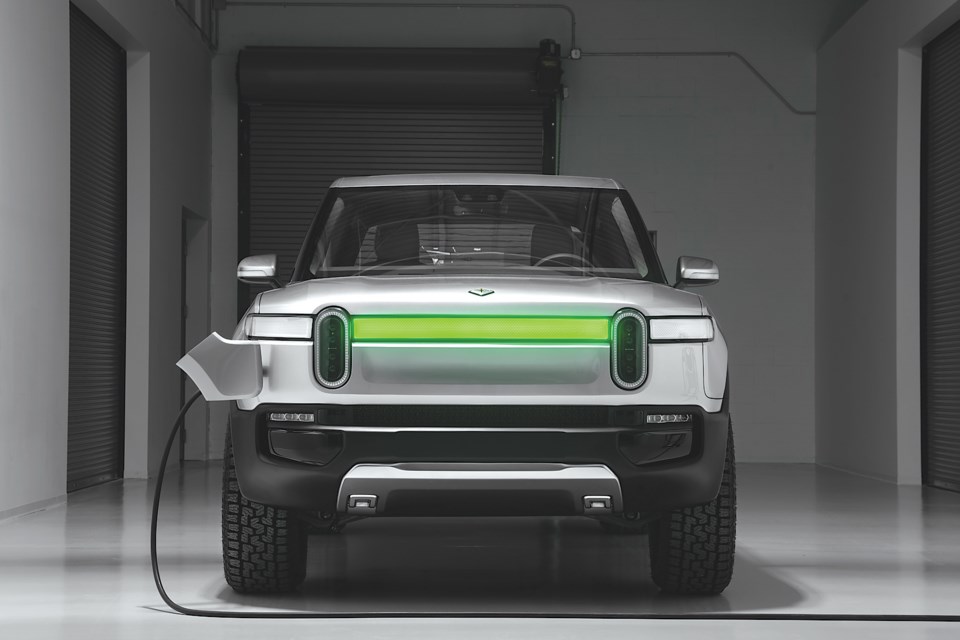A biweekly roundup of automotive news, good, bad and just plain weird:
Electric pickup lights up L.A. auto show
For a place so focused on mobility options and the future of autonomous driving, some of the debuts at this year’s Los Angeles Auto Show were downright old school. Jeep’s Gladiator, for instance, is basically a Wrangler with a pickup bed: plenty of off-road capability, but still a heavy, thirsty vehicle.
What a contrast was the surprise of the show from a start-up company called Rivian, which came out of the gate with two production-ready vehicles. The R1T and the R1S are a related truck and SUV, both featuring range and acceleration figures that match anything Tesla currently has on the market.
The numbers are impressive. With electric motors at each wheel providing all-wheel drive and nearly 800 horsepower, both vehicles will run up to 100 kilometres per hour in less than three seconds. They’ll also tow a projected 5,000 kilograms, and have an expected range of 644 kilometres.
The price of all this power hasn’t been set yet, but Rivian expects costs of their electric pickup to come in around US$70,000 for an entry-level model, and $90,000 for the long-distance battery. That’s in the ballpark for a Tesla Model S or X.
Of course, there’ve been plenty of electric startups over the last few years, but Rivian does seem to have the support network required to make a go of things, including design and engineering centres in Los Angeles and Detroit, and a former Mitsubishi factory in Illinois. With the pickup market stronger than ever, the timing looks great.
As for the Gladiator? Sure, it’s a little outdated by comparison, but you can bet they’re going to sell every one of those too.
Cops pull over sleeping driver – at 110 km/h
Early in the morning on Friday of last week, two patrolling officers spotted a suspected drunk driver traveling along Highway 101 in California. The driver wasn’t speeding, but didn’t respond to lights or siren. When the officers pulled up alongside, they saw that the driver was asleep.
As the car in question was a Tesla Model S, the quick-thinking officers reasoned that automated cruise control systems were keeping the car’s speed constant. They came up with a plan to stop the car without potentially causing a crash.
With another cruiser called in to hold station behind and keep other motorists at bay, the CHP officers pulled in front of the Tesla, and began slowing to a stop. The car’s sensors picked up the cruiser, and it too slowed down in tandem. Then, they knocked on the door – rather loudly, I expect – and arrested the driver on suspicion of driving under the influence.
Tesla possibly deserves a little blame here for marketing their driver assist systems as “Autopilot,” which indicates a level of capability that simply isn’t there yet. It’s not a fully autonomous system, but an automated one, the difference being that a driver must pay attention. Of course, Tesla does point this out in their terms of service, so the ultimate responsibility lies solely with the driver. Also, the car’s technology did, in the end, prevent a crash.
As automated features roll out across our vehicles, you can bet that this sort of behaviour is going to become more prevalent. We all tend to over-trust technology to protect us from bad decisions. Just remember that, whether you’re reaching for your phone or that “one more can’t hurt” drink, the responsibility behind the wheel still belongs to you.
Aston Martin shows off reversible electric DB6 Volante
Electric pickups, automated moving violations, and now this: a classic Aston Martin converted to silent electric power. Isn’t half the fun of owning an Aston Martin listening to the roar of its engine under power? Or at least the roar of the starter motor as the damn thing breaks down on the side of the road again?
Well, here’s Aston Martin with their new electric-cassette concept. (No, not the kind of cassette you have to rewind with a Bic pen.)
The cassette concept basically means that the entire electric drivetrain takes up the same space as the gasoline-powered bits, and can be fully swapped in without modifying any bodywork. Thus, you can swap your classic to electric power for its acceleration and reliability, but still keep open the option of putting the oily parts back in for originality.
This isn’t as crazy as you’d think, particularly in a world where rare Porsche owners sometimes remove their numbers-matching engines, and put in “tribute” versions that can be more easily rebuilt if something goes sproing.
Further, imagine you lived in London and wanted to swan about town on the weekend without getting stuck. An electric DB6 Volante would be just the stylish way to do it, and because you weren’t dumping 1970s hydrocarbons directly into the face of cyclists and pedestrians, people would be less inclined to lob a rotten cabbage at your head.
In the near-future, there’s probably room for purists who love the fizz and crackle of an internal combustion engine driven only on special days, and those who’d like their classic styling mixed with modern bits under the hood. Aston’s cassette sounds like just the kind of mixtape people can groove too, even though it doesn’t make a sound.
Watch this space for all the best and worst of automotive news, or submit your own auto oddities to [email protected].



